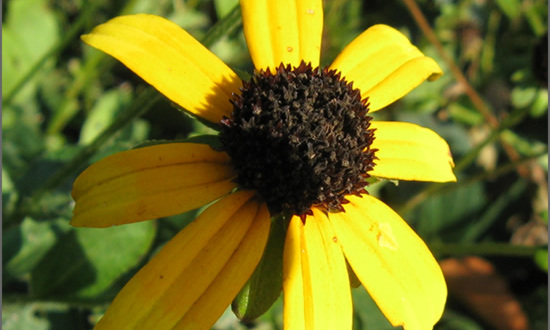Black-eyed Susan, Gloriosa Daisy, Yellow Ox-eye Daisy. I grow it as an annual. Black-eyed Susans (Rudbeckia hirta) are native to North America and one of the most popular wildflowers grown. They tend to blanket open fields, often surprising the passer-by with their golden-yellow beauty.
Members of the sunflower family, the “black eye” is named for the dark brown-purple centers of its daisy-like flower heads. The plants can grow to over 3 feet tall, with leaves of 6 inches, stalks over 8 inches long and flower diameter of 2 to 3 inches.
Butterflies, bees and a variety of insects are attracted to the flowers for the nectar. As they drink the nectar, they move pollen from one plant to another, causing it to grow fruits and seeds that can move about easily with the wind.
These plants bloom from June to October. Note that they can be territorial in that they tend to squash out other flowers growing near them. The Black-eyes Susans grow well in Sunnyvale gardens.
Black-eyed Susans are good for cut flowers; they also work well for borders or in containers.
Details
Family: Asteraceae (ass-ter-AY-see-ee) (Info)
Genus: Rudbeckia (rud-BEK-ee-a) (Info)
Species: hirta (HER-tuh) (Info)
Category: Annuals; Biennials; Perennials
Height: 18-24 in. (45-60 cm); 24-36 in. (60-90 cm)
Spacing: 12-15 in. (30-38 cm)
Hardiness:
USDA Zone 5a: to -28.8 °C (-20 °F)
USDA Zone 5b: to -26.1 °C (-15 °F)
USDA Zone 6a: to -23.3 °C (-10 °F)
USDA Zone 6b: to -20.5 °C (-5 °F)
USDA Zone 7a: to -17.7 °C (0 °F)
USDA Zone 7b: to -14.9 °C (5 °F)
USDA Zone 8a: to -12.2 °C (10 °F)
USDA Zone 8b: to -9.4 °C (15 °F)
USDA Zone 9a: to -6.6 °C (20 °F)
USDA Zone 9b: to -3.8 °C (25 °F)
USDA Zone 10a: to -1.1 °C (30 °F)
USDA Zone 10b: to 1.7 °C (35 °F)
Sun Exposure: Sun to Partial Shade
Danger: All parts of plant are poisonous if ingested
Bloom Color: Bright Yellow
Bloom Time: Mid Summer; Late Summer/Early Fall
Foliage: Herbaceous
Other details:
May be a noxious weed or invasive. This plant is attractive to bees, butterflies and/or birds. Drought-tolerant; suitable for xeriscaping
Average Water Needs; Water regularly; do not overwater
Self-sows freely; deadhead if you do not want volunteer seedlings next season
This plant is resistant to deer
Soil pH requirements: 5.6 to 6.0 (acidic); 6.1 to 6.5 (mildly acidic); 6.6 to 7.5 (neutral)
Patent Information: Non-patented
Propagation Methods: From seed; direct sow outdoors in fall. From seed; direct sow after last frost
Seed Collecting: Allow seedheads to dry on plants; remove and collect seeds. Wear gloves to protect hands when handling seeds. Properly cleaned, seed can be successfully stored
Read more: http://davesgarden.com/guides/pf/go/25/#ixzz3HZpMTot7








